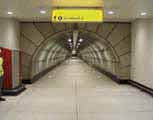| |
 |
After being approached by Optical Networks Ltd, the commmunications contractor for the Heathrow Express rail link, Penton UK developed a custom-made emergency loudspeaker for the platform and concourse areas of the project.
The brief given was that the new speaker should comply to a standard in keeping with what is now known as BS 5839 Section 8, 1998 (a new standard for Fire Detection and Alarm Systems for buildings). Penton came up with the CELL6/T projector loudspeaker, over 700 of which were to be used in the system. Each was fitted with stainless steel flexible conduct, through which cables capable of operating at high temperatures were passed from the loudspeaker into a modular Termination Bracket. The units were coated in a zero-halogen epoxy paint to comply to the same safety standards, as laid down by the London Underground Ltd. The termination arrangement was designed to mount onto a purpose-made extruded cable containing unit, allowing for easy access for maintenence, and for relocation of the units as required. Penton also supplied ceiling loudspeakers for the project - RCS6/FTS model units, with steel fire domes and Modular Termination Brackets also compliant with BS5839 Section 8. A number of the CELL6/T projectors were fitted with an end-of-line monitoring and mute relays for checking on the status of the speaker lines. Optical Networks Ltd have been involved with the project since 1993, during which time the company have been responsable for the provision of site-wide communications needs, including everything from telephone (PABX) and PA systems to the fire alarm, SCADA, gas monitoring, CCTV, train information systems and passenger help points. The original system design was changed in favour of ‘Optical Networks’ proprietry fibre-optic backbone system, which provided greater flexibility. All services are now linked - across 14 different areas - with Optical’s OTN system nodes. For example, the PABX system comes complete with touch-screen operator terminals into which the passenger help points are directly connected via the PABX. In an emergency situation, announcements will automatically direct passengers to the safest and nearest exit in relation to the incident. The system is run through two diversly-routed fibre optic cables, forming rings, which connect the multiple nodes across the site. This allows for a secure and reliable signal path - if one ring is interrupted, the otherwill seamlessly take over; another advantage is that replacement nodes and interfaces can be added, or obsolete ones removed, at any time without affecting the system. Although the final design was complete by summer 1997, further sub-systems have been incorporated as late as Febuary 1998, without disruption to services. |
||
|